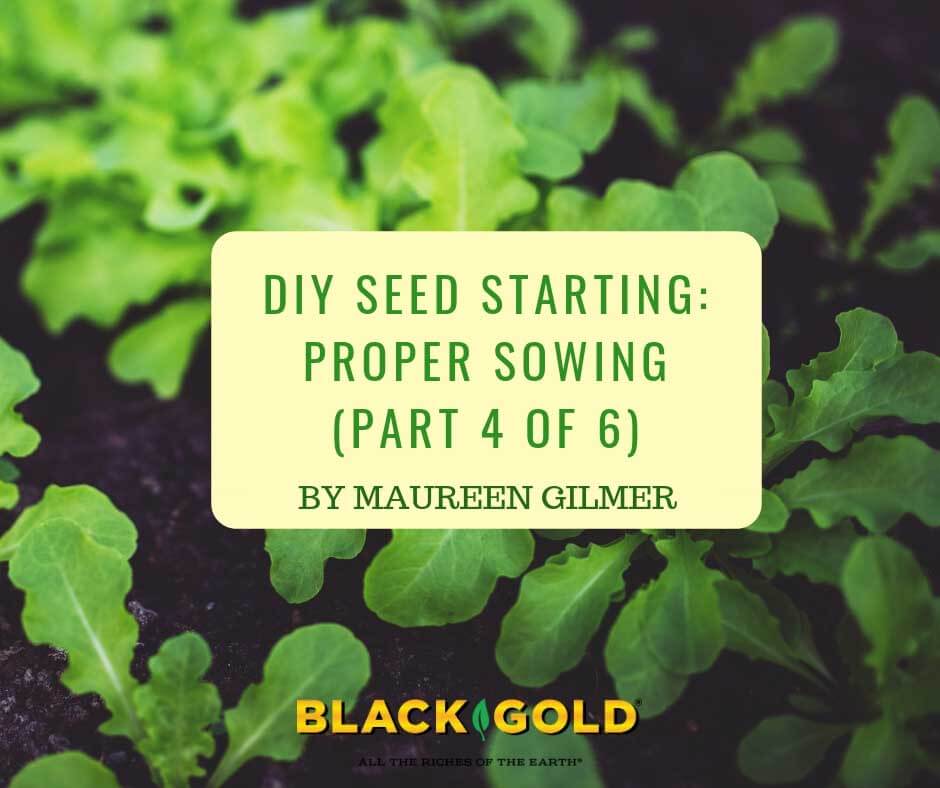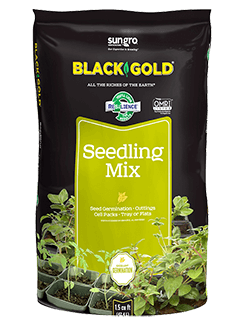
The first step of any seed sowing project is to read the entire label of the seed packet. That tells you how deep to plant each kind of seed and under what growing conditions. Those that are usually started indoors may be surface sown or planted 1/2 inch deep, depending on seed size and growing preferences. Each plant’s seeds have there own needs for germination, and some requirements are more complicated than others. Lucky, the seeds of garden vegetables and most annuals are quite easy to grow.
Choose the Right Mix
Whether you sow into cell pack trays or directly into individual containers, make sure you use fresh Black Gold Seedling Mix to provide a good growing environment. It is a soilless mixture, often called media, is comprised of fine Canadian sphagnum peat moss, perlite, and a wetting agent. These ingredients ensure that it’s lightweight and takes up water easily. Set aside a container of dry media, then moisten it before filling your containers. Press it gently into your growing containers, but don’t it pack down, so it remains porous enough to for oxygen and moisture exchange.
 The Right Planting Depth
The Right Planting Depth
Before planting, created holes at the required depth using a dibble stick or repurposed knitting needle in your cells or pots. If you’re growing in a tray or recycled container score rows in the media to the indicated depth. If you’re growing in 4-inch pots, poke three seed holes spaced apart. Now it’s ready for the pots to receive seed.
There’s no challenge with large seeds because these are easy to sow with your fingers and require a deeper planting depth. The tiny ones can be a bigger challenge to handle. Some gardeners take a piece of scrap paper and fold it in half. Into the V at the bottom, a small number of seeds may be placed; then the paper held folded. Tap the bottom and from the lower end of the fold will come the tiny seeds. They’ll drop precisely into your rows or pots, one at a time. Beware of planting too densely because this makes it tough to untangle the seedlings when the time comes to transplant them. Very tiny seeds should also be sown on the surface. After watering, they will become covered enough with media. (To learn more about seed sowing depths for popular crops, click here.)
Once sown, use any reserved dry media to cover seeds. For deeper planted seed cover them with excavated material from the planting hole or row. Then gently press down the media to ensure good soil contact.
Storing Seeds
When sowing is completed, be sure to seal any remaining seeds inside their packets, and store them in a cool, dry place. If you have an unexpected germination problem, the backup seed will be vital for replanting. Being able to refer back to the instructions in the packet can also come in handy.
READ MORE ARTICLES FROM THIS SERIES…
- Start Vegetable Seed Indoors Early
- DIY Seed Starting: Seed Packets (Part 1 of 6)
- DIY Seed Starting: Damping Off Prevention (Part 2 of 6):
- DIY Seed Starting: Containers (Part 3 of 6)
- DIY Seed Starting: Proper Sowing (Part 4 of 6)
- DIY Seed Starting: Watering (Part 5 of 6)
- DIY Seed Starting: Transplanting Seedlings (Part 6 of 6)

